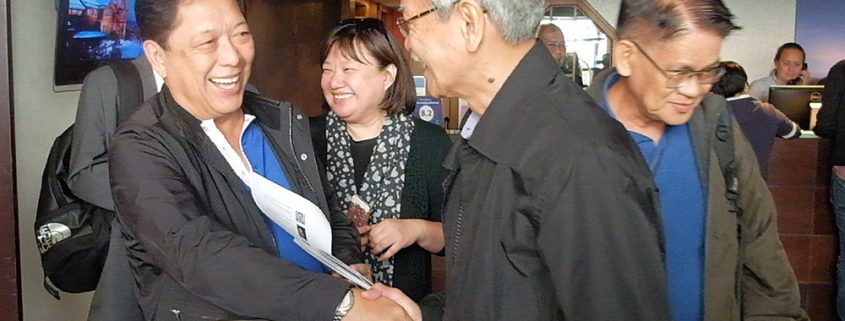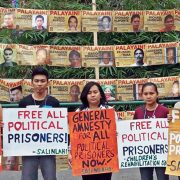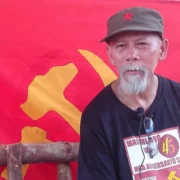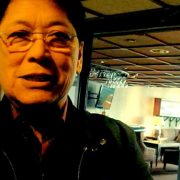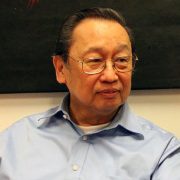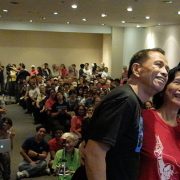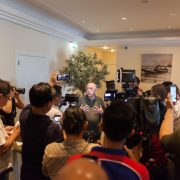It is far from freezing cold in Oslo
OSLO—It had been more than five years since the last formal peace negotiations between the Government of the Republic of the Philippines (GRP, the original name used for the peace talks) and the National Democratic Front of the Philippines (NDFP) in this Norwegian capital. It was the dead of winter in February 2011, the weather as cold as the relations between the then Gloria Macapagal Arroyo government and its negotiating team led by presidential peace adviser Teresita Deles and the revolutionary umbrella group chiefly represented by former Roman Catholic priest Luis Jalandoni.
Both peace panels tried to be friendly then, but it was an impossible mission of sorts.
On the eve of the opening of the last formal talks in February 18, 2011 long-time NDFP consultant Alan Jazmines was arrested in Bulacan, Philippines. The talks almost did not push through despite the arrival of both panels in this city. They negotiated hard to resolve the complication brought about by Jazmines’ arrest by the Philippine Army. Expectedly, the NDFP demanded the immediate release of their “very-valued consultant,” one that the then GPH (Government of the Philippines, its name under the Benigno Aquino government) was hard-pressed to deny was a Joint Agreement on Safety and Immunity Guarantees identification card holder.
Deles’ insistence on addressing both panels at the head of the table with the Norwegian facilitators further complicated matters. Again, the NDFP protested. They said Deles must only deliver the GPH’s opening statement from their own side of the bargaining table. The NDFP refused to let Deles show them that her office was above both negotiating panels in what was supposed to be a bilateral negotiation. Deles eventually delivered her speech from the GPH panel’s table, directly across NDFP’s Jalandoni.
The delay of a few hours made the opening ceremony tensed and as cold as the weather outside the conference hall windows. Clearly, there was no love lost between both panels in the 2011 formal talks.
After four days of negotiations, it was not sure that the GRP and NDFP panels would be able to hammer out an agreement. The scheduled closing ceremony on February 22 was postponed three times on the issue of the release of detained NDFP consultants. After the GPH committed to undertake steps for the freedom of the consultants, it was only then that the closing ceremony pushed through at about eight o’clock in the evening with an issuance of a joint statement.
In their Joint Oslo Statement of February 22, 2011, both parties committed to hold more talks to hammer out a Comprehensive Agreement on Social and Economic Reforms. The GPH also committed to undertake steps to release NDFP consultants, including Jazmines.
“The GPH panel is committed to stay the course of peace. The goal of a just and enduring peace has compelled us to come to the table, and to stay at the table,” GPH chief negotiator Alexander Padilla said at the time.
But there have been no more GPH-NDFP formal negotiations under the Benigno Aquino government. Instead, the Aquino government’s Internal Security Plan-Oplan Bayanihan was ramped up, sending more military detachments to civilian and indigenous peoples’ communities. More NDFP consultants were also arrested, most notably Benito and Wilma Tiamzon, alleged Communist Party of the Philippines (CPP) top leaders.
To underscore the breakdown of the GPH-NDFP negotiations, Padilla subsequently unilaterally declared the peace talks dead, despite the fact that it takes a bilateral agreement for such a declaration.
Meanwhile, the New People’s Army and the CPP reported substantial year-on-year increases in membership. In Mindanao alone, now NPA National Operational Command spokesperson Jorge Madlos said that their guerrilla fronts increased by six from 40 in 2014 to 2015. Madlos added that the NPA’s operations in Mindanao already cover 2,500 barrios from 1,850 five years ago. Aquino’s preference for a military approach in dealing with the Reds failed.
And then a Mindanaoan GRP President came, one who has a long history of friendship and cooperation with the CPP and the NPA.
“Peace Talks President”
Even as city mayor, Duterte has repeatedly declared support for the GPH/GRP-NDFP peace talks. He could be depended upon by the NPA to act as go-between for the release of their prisoners of war. In 2011, he even volunteered to become an NDFP consultant for Mindanao, which was readily accepted by the NDFP. This prompted the late GRP Interior Secretary Jesse Robredo to rush to Davao to ask Duterte to withdraw. Duterte could not be an NDFP consultant being an elected GPH official, Robredo reportedly told him. Realizing the awkward position he put himself in, the Davao mayor quietly withdrew from the NDFP peace negotiating team. Duterte, however, continued to nurture a respectful, albeit uneasy, relationship with the guerrillas.
As a presidential candidate, Duterte sent strong messages that he will revive formal peace negotiations with the NDFP. After his landslide victory, he declared his intention to free all political prisoners through a general amnesty.
After assuming office, however, Duterte started modifying his statements, saying the general amnesty would only come after a final peace agreement has been forged through the peace talks. The exigencies of being the GRP’s chief executive and AFP’s commander in chief also came into play. In his visits to 14 military camps since he became president, he uttered strong words against the CPP, NPA and the NDFP, more so after the NPA ambushed a Philippine Army and Civilian Auxiliary Force Geographical Unit (CAFGU) group in Southern Mindanao that killed a soldier. The NPA said it was an act of defense, as the Philippine Army was out of their camp in an offensive mission despite Duterte’s ceasefire order.
After his victory in the May 9 elections, Duterte sent three of his peace negotiators to Oslo (Jesus Dureza, Silvestre Bello and Hernani Braganza) for preliminary talks with the NDFP. It resulted in a joint statement where both panels promised they will resume formal talks, discuss the affirmation of previously-signed agreements, and work for the release of political prisoners. Kodao reported the talks to be “very cordial and hopeful.”
Such big commitments are easier said than done, of course. It was only through sheer hard work and determination that both panels were able to release 19 NDFP consultants so they could participate in the negotiations. The scheduled resumption of formal talks was postponed three times from the third week of July to allow the GRP more time to effect the release of the NDFP consultants. In fact, because of the many criminal charges that several NDFP consultants were facing in various trial courts across the country and the intransigence of some jail wardens, they were released mere hours before their respective flights to this city.
As the peace talks participants were making their way to Oslo, the Communist Party of the Philippines announced their unilateral ceasefire declaration. It also announced the release of four NPA prisoners of war in Southern Mindanao as an act of goodwill supporting the talks. The GRP immediately reciprocated by announcing its own unilateral ceasefire declaration a few hours before its main group of negotiators were to fly out to Oslo last Saturday. It was, as Presidential Peace Adviser Jesus Dureza described, a historic event.
Warm smiles and tight embraces
One by one, buses from the airport had been arriving at the Scandic Holmenkollen Park Hotel above Oslo throughout this afternoon, Sunday, from which emerged GRP and NDFP negotiators and staff. At the hotel lobby they exchanged cross-panel handshakes, tight embraces and warm smiles with others who arrived earlier. Their laughter punctured the usually quiet Holmenkollen district.
When most participants have arrived, including majority of the 19 NDFP consultants who have been recently released, they shared a toast led by Norwegian Ministry of Foreign Affairs officials. Tomorrow, they start what could indeed be the most historic peace negotiations.
It is still cold here, despite being summer in Norway. But the air is far from freezing cold as when both parties last formally met here in February 2011. # (Raymund B. Villanueva)

